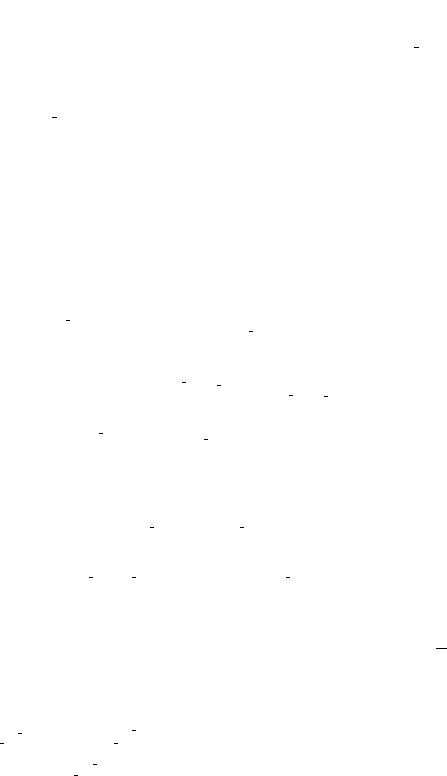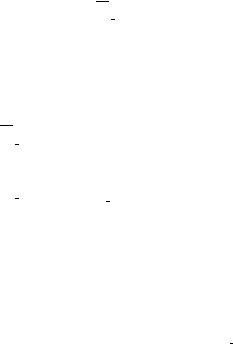
Introduction to Supersymmetry
.pdf
2.2. SPINORS |
|
|
|
|
|
|
|
|
5 |
||||
|
|
|
|
|
|
|
|
|
|
|
|
||
inequivalent representations. A two-component object transforming as |
|
||||||||||||
|
|
|
|
|
|
|
_ |
|
|
|
|
|
|
|
|
|
! |
0 = M |
|
_ |
(2.7) |
||||||
is called a dotted spinor, while the above |
is called an undotted one. Comparing |
||||||||||||
|
|
|
|
|
|||||||||
the complex conjugate of (2.6) with (2.7) we see that we can identify |
with |
||||||||||||
( ) . |
|
|
|
|
|
|
|
|
|
||||
The representation carried by the |
is called (21 ; 0) (matrices M) and the |
||||||||||||
one carried by the |
|
is called (0; 21 ) (matrices M ). They are both irreducible. |
|||||||||||
Now, any Sl(2; C) matrix can be written as |
|
|
|
|
|
|
|||||||
|
|
M = |
exp(aj j + ibj j ) |
(2.8) |
|||||||||
|
|
M = |
exp(aj j ibj j ) : |
||||||||||
|
|
|
|||||||||||
This explicitly displays the generators as the spin 12 representation of the complexi ed SU(2), in accordance with (2.2).
It proves very useful to now introduce some notations and conventions. We intoduce the antisymmetric two-index tensors
|
1 |
0 |
|
|
|
1 |
0 |
|
= _ = |
0 |
1 |
; = |
_ |
= |
0 |
1 |
(2.9) |
which are used to raise and lower indices as follows:
|
|
|
|
_ |
|
|
|
|
|
|
|
|
_ |
|
|
= ; |
= ; |
|
|
= _ |
; |
|
|
= |
_ |
|
|
: |
(2.10) |
||
|
|
|
|
|
|
|
|
|
|
|
|
|
|
|
|
One can then easily show that the transformation under an element M of Sl(2; C)
|
|
|
|
|
_ |
is 0 = (M 1) and 0 |
= |
|
(M 1) _ . |
||
The four matrices introduced above naturally have a dotted and an undotted index. Recalling that our signature is +,-,-,- we have
( ) = (1; i) : |
(2.11) |
Raising the indices using the tensors yields |
|
_ |
(2.12) |
( ) = ( ) _ = (1; + i) : |
|
|
|
Whenever we consider expressions involving more than one spinor we have to remember that spinors anticommute. Hence (with two-component spinors)
1 2 = 2 1, as well as 1 2_ = 2_ 1 etc. The scalar products and are de ned as
|
|
|
|
= |
= = = |
= |
|||||||||
|
|
|
|
|
|
|
|
|
|
|
|
|
|||
|
|
|
|
|
|
|
|
|
|||||||
|
|
= |
: : : = |
(2.13) |
|||||||||||
|
|
( )y |
|
|
|
= |
|
= |
|
: |
|
||||
|
|
= |
|
|
|
|
|||||||||
|
|
|
|
|
|
|
|
|
|
|
|
|
|
|
|
5

6 |
|
CHAPTER 2. SPINORS AND THE POINCARE GROUP |
Note that by convention undotted indices are always contracted from upper left to lower right, while dotted indices are always contracted from lower left to upper right. Note however that this rule does not apply when rising or lowering spinor indices with the -tensor. With this rule we also have
= |
|
_ |
|
|
|
|
|
|
; = : |
|
|||||||
_ |
(2.14) |
|||||||
|
|
|
|
|
|
|
|
|
One can then prove a certain amount of useful identities which we summarise
here: |
|
|
|
|
|
|
|
|
|
|
|
|
|
|
|
|
|
|
|
|
|
|
|
|
= |
|
|
; |
|
|
= |
|
|
||||||||||
( |
|
|
)y = |
|
|
; |
|
( |
)y = |
|
|
|
|
(2.15) |
|||||||
|
|
|
|
|
|
||||||||||||||||
= |
; |
|
|
|
= |
|
; ( )y = |
|
: |
|
|
||||||||||
Dirac spinors |
|
|
|
|
|
|
|
|
|
|
|
|
|
|
|
|
|
|
|
|
|
One introduces the Dirac matrices in the Weyl representation as |
(2.16) |
||||||||||||||||||||
= |
|
0 |
|
; 5 |
= i0 1 2 3 = |
0 |
|
|
1 |
|
|||||||||||
|
|
0 |
|
|
|
|
|
|
|
|
|
1 |
0 |
|
|
||||||
A four-component Dirac spinor is made from a two-component undotted and a |
||||||||||||||||
two-component dotted spinor as |
. Clearly it transforms as the reducible |
|||||||||||||||
1 |
1 |
|
|
|
|
|
|
|
|
|
|
|
0 |
|||
(2 ; 0) |
(0; 2 ) representation of the Lorentz group. Then |
0 and |
are |
|||||||||||||
chiral Dirac (or Weyl) spinors. A Majorana spinor is a Dirac spinor with , |
||||||||||||||||
i.e. it is of the form |
|
!. The Lorentz generators are |
|
|
||||||||||||
|
|
|
||||||||||||||
= |
|
i |
; = |
|
1 |
( |
|
|
) = |
1 |
|
|
0 |
: |
||
2 |
2 |
|
2 |
|
||||||||||||
|
|
|
|
|
|
0 |
|
|||||||||
|
|
|
|
|
|
|
|
|
|
|
|
|
|
|
(2.17) |
|
We see that indeed the undotted and dotted spinors transform separately, the
generators being i for |
and i for |
|
|
with |
|
|
|
||||||||||||||||
|
|
|
|
|
|||||||||||||||||||
|
|
|
|
( ) |
= |
|
41 |
( $ ) |
(2.18) |
||||||||||||||
|
|
|
|
( ) _ = |
|
41 |
_ ( $ ) |
: |
|
|
|||||||||||||
Note that e.g. 12 |
|
12 |
= |
|
i |
|
|
|
|
|
|
i |
|
|
|
so that the rotation generator M |
|
= |
|||||
|
|
|
|
|
|
|
|
|
|
|
|||||||||||||
M |
12 |
1 |
= |
|
|
2 |
|
3 |
2 |
z |
|
|
|
12 |
|
||||||||
|
is 2 z as expected. |
|
|
|
|
|
|
|
|
|
|
|
|
|
|
|
|
|
|
|
|||
Casimirs: mass and helicity |
|
|
|
|
|
|
|
|
|
|
|
|
|
|
|
|
|
|
|||||
|
A useful quantity is the Pauli-Lubanski vector |
|
|
|
|||||||||||||||||||
|
|
|
|
|
|
W |
|
= |
|
1 |
|
|
P M ; |
(2.19) |
|||||||||
|
|
|
|
|
|
|
|
2 |
|
|
|
|
|||||||||||
|
|
|
|
|
|
|
|
|
|
|
|
|
|
|
|
|
|
|
|
|
|
||
6
2.2. SPINORS |
7 |
which can be easily shown to commute with the P and behaves as a four-vector under commutation with the Lorentz generators. It follows that W 2 W W as well as P 2 P P commute with all the generators, i.e. they are two (and the only two) Casimirs of the Poincare group. For a massive particle one can go to the rest frame where P = (m; 0; 0; 0) and then P 2 = m2 and W 2 = m2s(s+1) where s is the spin of the particle. The di erent states of this irreducible representation are distinguished by the value of pi and of M12 J3 = S3 in the rest frame because in the rest frame only the spin and not the orbital part contributes to the angular momentum. In the above representation of dotted or undotted spinors one has of course s = 12 . For a massless particle P 2 = 0 and also W 2 = 0. We may take P = (E; 0; 0; E) so that W = M12P with M12 = s being the helicity. For such massless particles s is xed and the di erent states of this irreducible representation are distinguished by the sign of the helicity and by the values of pi.
7
8 |
|
CHAPTER 2. SPINORS AND THE POINCARE GROUP |
8

Chapter 3
The susy algebra and its representations
3.1The supersymmetry algebra
We want to enlarge the Poincare algebra by generators that transform either as undotted spinors QI or as dotted spinors QI under the Lorentz group and
that commute with the translations. The extra index I = 1; : : : N labels the di erent spinorial generators in case there are more than one pair. This means that according to (2.18)
[P ; QI ] = 0 ; [P ; QI ] = 0 ;
|
|
|
|
|
|
|
|
|
|
[M ; QI |
] = i( ) QI ; |
|
|
|
|
|
|
(3.1) |
|||||||||
|
|
|
|
|
|
|
|
|
|
|
|
|
|
|
|
|
|||||||||||
|
|
|
|
|
|
|
|
|
|
|
|
|
|
|
|
|
|
|
|
_ |
|
|
|
|
|
|
|
|
|
|
|
|
|
|
|
|
[M ; QI |
] = i( ) _ QI : |
|
|
|
|
|
|
|
||||||||||
|
|
|
|
|
|
|
|
|
|
|
|
|
|
|
|
|
|
|
|
|
|
|
|
|
|
||
In particular, M12 J3 and thus [J3; Q1I ] = |
21 Q1I and [J3; Q2I ] = 21 Q2I . Since |
||||||||||||||||||||||||||
Q |
I1 = |
|
(QI )y |
and |
Q |
I2 |
= (QI )y |
one similarly has [J |
; (QI )y] = |
1 |
(QI )y and |
||||||||||||||||
[J |
|
2 |
|
1 |
|
|
|
1 |
|
|
|
|
|
|
|
|
3 |
|
2 |
|
|
2 |
2 |
||||
; (QI )y] = |
2 |
(QI )y. We conclude that QI |
and (QI )y |
rise the z-component |
|||||||||||||||||||||||
3 |
1 |
|
|
1 |
|
|
|
|
|
|
|
|
|
1 |
2 |
|
|
|
|
|
|
||||||
of the spin (helicity) by half a unit, while Q2I and (Q1I )y lower it by half a unit. |
|||||||||||||||||||||||||||
|
|
Since the QI |
transform in the ( |
1 ; 0) representation and the |
|
I |
in the (0; 1 ), |
||||||||||||||||||||
|
|
Q |
|||||||||||||||||||||||||
|
|
|
|
|
|
|
|
|
|
|
|
|
|
|
|
|
2 |
|
|
|
|
|
|
|
|
|
2 |
the anticommutator of QI |
and |
|
J must transform as (1 |
; 1 ), i.e. as a four vector. |
|||||||||||||||||||||||
Q |
|||||||||||||||||||||||||||
|
|
|
|
|
|
|
|
|
|
|
|
|
|
|
2 |
2 |
|
|
|
|
|
||||||
The obvious candidate is P so that we arrive at |
|
|
|
|
|
|
|
||||||||||||||||||||
|
|
|
|
|
|
|
|
|
|
fQI ; |
|
J g = 2 _ P IJ : |
|
|
|
|
|
|
|
||||||||
|
|
|
|
|
|
|
|
|
|
Q |
|
|
|
|
|
|
(3.2) |
||||||||||
9

10 CHAPTER 3. THE SUSY ALGEBRA AND ITS REPRESENTATIONS
The IJ can always be achieved by diagonalising an a priori arbitrary symmetric matrix and by rescaling the Q and Q. Furthermore, since Q is the adjoint of Q, positivity of the Hilbert space excludes zero eigenvalues of this matrix. Finally
fQI ; QJ g = ZIJ ; f |
|
I ; |
|
J g = _ (ZIJ ) : |
|
Q |
Q |
(3.3) |
The ZIJ = ZJI are central charges which means they commute with all generators of the full algebra. The simplest algebra has N = 1, i.e. there are no indices I; J and there is no possibility of central charges. This is the unextended susy algebra. If N > 1 one talks about extended supersymmetry. In the simplest extended case, N = 2, there is just one central charge Z Z12. From the algebraic point of view there is no limit on N, but we will see that with increasing N the theories also must contain particles of increasing spin and there seem to be no consistent quantum eld theories with spins larger than one (without gravity) or larger than two (with gravity) leading to N 4, resp. N 8.
3.2Some basic properties
Using the above susy algebra it is easy to establish some basic properties of supersymmetric theories. Since the full susy algebra contains the Poincare algebra as a subalgebra, any representation of the full susy algebra also gives a representation of the Poincare algebra, although in general a reducible one. Since each irreducible representation (of the type considered above) of the Poincare algebra corresponds to a particle, an irreducible representation of the susy algebra in general corresponds to several particles. The corresponding states are related to
each other by the QI and QJ and thus have spins di ering by units of one half.
_
They form a supermultiplet. By abuse of language we will call an irreducioble representation of the susy algebra simply a supermultiplet. Clearly, using the spin-statistics theorem, the Q and Q change bosons into fermions and vice versa. One then has:
All particles belonging to an irreducible representation of susy, i.e. within one supermultiplet, have the same mass. This is obvious since P 2 commutes with all generators of the susy algebra, i.e. it is still a Casimir operator.
In a supersymmetric theory the energy P0 is always positive. To see this, let j i
be any state. Then by the positivity of the Hilbert space we have
0 |
jjQI j i jj2 + jj(QI )y j i jj2 = h j (QI )yQI + QI (QI )y j i |
(3.4) |
||
= |
h j fQI ; |
|
I gj i = 2 h j P j i |
|
Q |
|
|||
since (QI )y QI . Summing this over = 1; 2 and using tr = 2 0 yields
0 4 h j P0 j i, which was to be shown.
10

3.3. MASSLESS SUPERMULTIPLETS |
11 |
A supermultiplet always contains an equal number of bosonic and fermionic degrees of freedom. By degrees of freedom one means physical (positive norm) states. Hence a photon has two degrees of freedom corresponding to the two helicities +1 and 1 (the two polarizations). Let the fermion number be NF equal one on a fermionic state and 0 on a bosonic one. Equivalently ( )NF is +1 on bosons and 1 on fermions. We want to show that
Tr ( )NF = 0 |
(3.5) |
if the trace is taken over any nite-dimensional representation. Note that ( )NF anticommutes with Q. Using the cyclicity of the trace, one has
0 = |
Tr Q ( )NF |
|
_ + ( )NF |
|
_ Q = Tr ( )NF fQ ; |
|
_ g |
|
Q |
Q |
Q |
(3.6) |
|||||
= |
2 _ Tr ( )NF P : |
|
||||||
Choosing any non-vanishing momentum P gives the desired result.
3.3Massless supermultiplets
We will rst assume that all central charges ZIJ vanish. Below we will see that for massless representations this is necessarily a consequence of the positivity of the Hilbert space. Then all QI anticommute among themselves, and so do the
|
J |
. Since P 2 = 0 we choose a reference frame where P = E(1; 0; 0; 1) so that |
||||||||||||
Q |
||||||||||||||
|
|
|
|
|
|
|
|
|
|
|
|
|
|
|
P = |
0 |
0 |
and thus |
|
|
|
|
|
|
|
|
|
||
0 |
2E |
|
|
|
|
|
|
|
|
|
||||
|
|
|
|
|
fQI |
|
|
J |
|
0 |
0 |
_ |
IJ : |
|
|
|
|
|
|
|
|
|
|||||||
|
|
|
|
|
; Q _ g = |
0 |
4E |
(3.7) |
||||||
I |
J |
|
In particuler, fQJ1; Q1_ g = 0; 8I; J. On a positive de nite Hilbert space we must |
||
then set Q1I = Q1_ = 0; 8I; J. The argument is similar to the one above: |
|
|
0 = h jfQ1I ; Q1I_ gj i = jjQ1I j i jj2 + jjQ1I_ j i jj2 ) Q1I = Q1J_ = 0 |
(3.8) |
|
Thus we are left with only the QI2 generators. If we de ne
J
and Q2_ , i.e. N of the initial 2N fermionic
|
p |
1 |
Q2I ; aIy = |
p |
1 |
|
|
2I |
|
|
aI = |
|
Q |
(3.9) |
|||||||
4E |
|
|||||||||
|
|
|
|
4E |
|
|||||
the aI and aIy are anticommuting annihilation and creation operators: |
|
|||||||||
faI ; aJy g = IJ ; |
faI ; aJ g = faIy; aJy g = 0 : |
(3.10) |
||||||||
11
12 CHAPTER 3. THE SUSY ALGEBRA AND ITS REPRESENTATIONS
One then chooses a \vacuum state", i.e. a state annihilated by all the aI . Such a state will carry some irreducible representation of the Poincare algebra, i.e. in addition to its zero mass it is characterised by some helicity 0. We denote
this state as |
j |
|
0i |
. From the commutators of QI |
and |
|
J |
with the helicity operator |
||
Q |
||||||||||
|
|
|
2 |
2_ |
I |
|||||
which in the present frame is J3 = M12 one sees that Q2 lowers the helicity by |
||||||||||
one half and |
|
|
J |
rises it by one half. (For simplicity, we suppose here that the |
||||||
|
Q |
|||||||||
|
|
|
|
2 |
|
|
|
|
|
|
state j 0i transforms as a singlet under the SU(N) that acts on the indices I; J. One could easily drop this restriction.) The supermultiplet then is of the form
j 0i
aIy j 0i = |
0 + 21 EI |
|
||||||
|
|
|
|
|
|
|
|
|
ayay |
|
0i |
= |
|
|
+ 1 |
iIJ |
(3.11) |
I J |
j |
|
j |
0 |
|
|
||
a1ya2y : : : aNy j 0i = |
: : : |
|
|
|
||||
0 + N2 E : |
|
|||||||
|
|
|
|
|
|
|
|
|
|
|
|
|
|
|
states with helicity = 0+ 2k , |
||
|
|
|
|
N |
||||
Due to the antisymmetry in I; J; : : : there are k |
||||||||
k = 0; 1; : : : N. Summing the binomial coe cients gives a total of 2N states with 2N 1 having integer helicity (bosons) and 2N 1 having half-integer helicity (fermions). In general, in such a supermultiplet, except if 0 = N4 , the helicities will not be distributed symmetrically about zero. Such supermultiplets cannot be invariant under CPT, since CPT ips the sign of the helicity. To satisfy CPT one then need to double these multiplets by adding their CPT conjugate with opposite helicities and opposite quantum numbers.
For unextended susy, N = 1, each massless supermultiplet only contains two
states |
|
and |
|
0 |
+ 1 |
. We denote these multiplets by ( 0; 0 + 1 ). They can |
|
0 |
|
|
|
2 |
2 |
j i |
|
|
|
|
conjugate and one needs to double them. Thus one arrives at |
|
never be CPT self- |
|
E |
||||
the following massless N = 1 multiplets:
The chiral multiplet consists of (0; 12 ) and its CPT conjugate ( 12 ; 0), corresponding to a Weyl fermion and a complex scalar.
The vector multiplet consists of ( 12 ; 1) plus ( 1; 12 ), corresponding to a gauge boson (massless vector) and a Weyl fermion, both necessarily in the adjoint representation of the gauge group.
The gravitino multiplet contains (1; 32 ) and ( 32 ; 1), i.e. a gravitino and a gauge boson.
The graviton multiplet contains ( 32 ; 2) and ( 2; 32 ), corresponding to the graviton and the gravitino.
12

3.4. MASSIVE SUPERMULTIPLETS |
13 |
Since we so not want helicities larger than two, we must stop here. Also the gravitino should be present only in a theory with gravity, so if N = 1 it must only occur once and then in the gravity multiplet. Hence the gravitino multiplet cannot appear in unextended susy. However it does appear in extended susy when decomposing larger multiplets into N = 1 multiplets.
For N = 2 a supermultiplet contains ( 0; 0 + 12 ; 0 + 12 ; 0 + 1). Restricting ourselves to the cases where the helicity does not exceed one, we have two possibilities.
The N = 2 vector multiplet |
contains (0; 1 |
; 1 |
; 1) and its |
CPT conjugate |
|
2 |
2 |
|
|
( 1; 21 ; 21 ; 0), corresponding to a vector (gauge boson), |
two Weyl fermions |
|||
and a complex scalar, again all in the adjoint representation of the gauge group. In terms of N = 1 representations this is a vector and a chiral N = 1 multiplet.
The hypermultiplet: If 0 = 12 we get ( 12 ; 0; 012 ). This may or not be CPT self-conjugate. If it is, it is called a half-hypermultiplet. If it is not we have to add its CPT conjugate to get a (full) hypermultiplet 2 ( 12 ; 0; 012 ).
For N = 4, restricting again to helicities not exceeding one, there is a single N = 4 multiplet which always is CPT self-conjugate. It is ( 1; 4 ( 12 ); 6 0; 4 12 ; 1), containing a vector 4 Weyl fermions and 3 complex scalars. In terms of N = 2 multiplets it is just the sum of the N = 2 vector multiplet and a hypermultiplet, however now all transforming in the adjoint of the gauge group.
3.4Massive supermultiplets
We now consider the case P 2 > 0 and a priori arbitrary central charges ZIJ . Going to the rest frame P = (m; 0; 0; 0), the susy algebra becomes
fQI ; (QJ )yg = 2m IJ |
|
||
fQI ; QJ g |
= |
ZIJ |
(3.12) |
f(QI )y; (QJ )yg |
= |
(ZIJ ) : |
|
By an appropriate U(N) rotation among the QI the antisymmetric matrix of
central charges can be brought into standard form: |
: : : 1 |
|
|||||
|
0 |
q1 |
01 |
0 |
0 |
|
|
|
B |
0 |
q |
0 |
0 |
C |
|
ZIJ = |
B |
0 |
0 |
q2 |
0 |
C |
|
B |
0 |
0 |
0 |
q2 |
C |
(3.13) |
|
|
B |
|
|
. |
|
C |
|
|
B |
|
|
. |
|
C |
|
|
B |
|
|
. |
|
C |
|
|
@ |
|
|
|
|
A |
|
13
14 CHAPTER 3. THE SUSY ALGEBRA AND ITS REPRESENTATIONS
with all qn 0, n = 1; : : : N2 . We assume that N is even, since otherwise there is an extra zero eigenvalue of the Z-matrix which can be handled trivially.
It follows that if we let
|
|
1 |
|
|
|
|
|
(Q2 )y |
|
|
a1 |
= |
|
|
|
Q1 |
+ |
|
|
||
|
|
p2 |
|
|
|
|
|
|
||
|
|
1 |
|
|
|
|
|
(Q2 )y |
||
b1 |
= |
|
|
|
Q1 |
|
|
|
|
|
|
|
p2 |
|
|
|
|
|
|||
|
|
1 |
|
|
|
|
|
(Q4 )y |
||
a2 |
= |
|
|
|
Q3 |
+ |
|
(3.14) |
||
|
|
p2 |
|
|
|
|
|
|||
|
|
1 |
|
|
|
|
|
(Q4 )y |
|
|
b2 |
= |
|
|
|
Q3 |
|
|
|
|
|
|
|
p2 |
|
|
|
|
|
|||
.
.
.
then the ar and br , r = 1; : : : N2 and their hermitian conjugates satisfy the following algebra of harmonic oscillators
far ; (as )yg = (2m qr) rs |
|
||
fbr ; (bs )yg |
= |
(2m + qr) rs |
(3.15) |
far ; (bs )yg |
= |
far ; as g = : : : = 0 |
|
Clearly, positivity of the Hilbert space requires that
2m jqnj |
(3.16) |
for all n. If some of the qn saturate the bound, i.e. are equal to m, then the corresponding operators must be set to zero, as we did in the massless case with the QI1. Clearly, in the massless case the bound becomes 0 jqnj and thus qn = 0 always. There cannot be central charges in the massless case and the bound is always saturated, thus only exactly have of the fermionic generators survive.
In the more general massive case, if all jqnj are strictly less than 2m we have a total of 2N harmonic oscillators. Then starting from a state of minimal \helicity" (i.e. z component of the angular momentum) 0 annihilated by all an and bn, application of the creation operators yields a total of 22N states with helicities ranging from 0 to 0 + N.
For N = 1 this yields four states, again labeled by their helicities (or rather the z component of the angular momentum), as ( 12 ; 0; 0; 12 ) (which is the same as the CPT extended massless multiplet) or ( 1; 12 ; 12 ; 0) to which we must add the CPT conjugate (1; 12 ; 12 ; 0). The latter are the same states as a massless vector plus a massless chiral multiplet and can be obtained from them via a Higgs mechanism. In terms of massive representations this is a vector (3 dofs) a Dirac fermion (4 dofs) and a single real scalar (1 dof).
14
